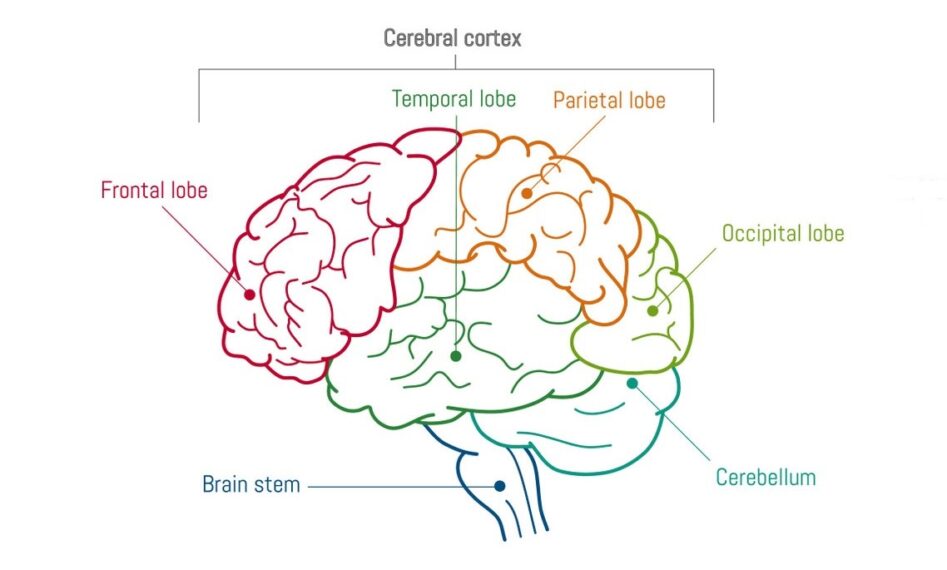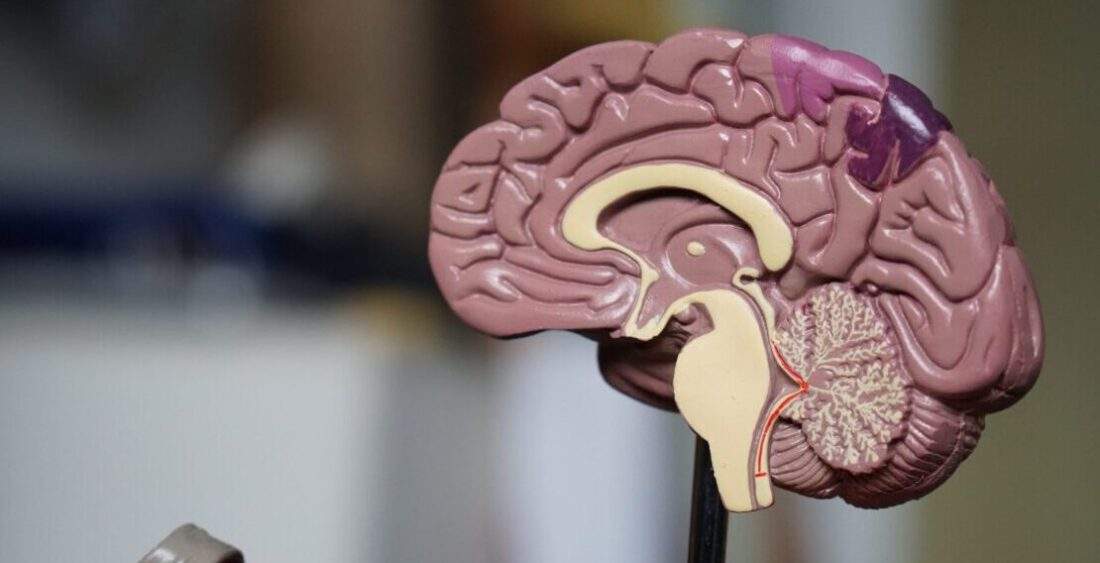Playback speed:
Dementia can affect the entire brain. Learn how the brain works and understand how changes in specific brain regions can affect the ways dementia symptoms manifest.
Overview of the Brain
The brain can be divided into three main regions:
1. Cerebrum (contains the cerebral cortex and other deeper brain structures)
2. Cerebellum
3. Brain stem
The sections below provide simple explanations of how the brain works and the functions associated with the three brain regions. It also explains how changes to each brain region can affect the way a person functions in specific ways.
1. The Cerebrum and Its Associated Functions
Cerebral cortex: Contains the frontal lobes, parietal lobes, occipital lobes, and temporal lobes.

Frontal Lobes
• The outer layer of the brain located at the front of the head (closer to the face).
• The site of executive functions, including working memory, reasoning, judgment,
decision-making, selective attention, and behavioral inhibition.
• Contains Broca’s area, which is involved in language production. Damage to this area can
cause Broca’s aphasia, where a person cannot speak fluently.
• In frontotemporal dementia, the frontal and temporal regions of the brain shrink.
The associated functions of these areas decline.
Parietal Lobes
• The outer layer of the brain located at the top of the head.
• This region processes and integrates sensory information (e.g. sight, space,
awareness of the position and movement of body parts, touch, taste, smell, and temperature).
• Damage to this can cause issues in perceiving, visualising,
and planning space and movement.
Occipital Lobes
• The outer layer of the brain located at the back of the head.
• This region receives and processes visual information from the eyes.
• It is involved in perceiving shape, colour, and movement.
• Damage to this lobe can cause issues with perceiving and recognising visual information.
Temporal Lobes
• The outer layer of the brain located closer to the bottom and sides of a person’s head,
near the ears.
• The temporal region processes hearing, memory encoding, and emotions
• It is also a site for language processing, and the learning and recall of non-verbal information.
• A brain region called Wernicke’s area, which processes the meaning of language
, is part of the temporal cortex.
• Damage to this area results in Wernicke’s aphasia, a condition where a person can speak
fluently but whose speech and writing do not make sense, and has
difficulties understanding others’ language.
• In frontotemporal dementia, the frontal and temporal regions of the brain shrink.
The associated functions of these areas decline.
Hippocampus
• Located just under the temporal cortex.
• It is needed for the formation of memories, especially for memories of life events.
Hypothalamus
•The hypothalamus is critical for the regulation of the body: for body temperature,
hydration, eating, sleep-wake cycles, and other functions.
• Changes to the hypothalamus and its interactions with other parts of the brain and body can affect
the body’s regulation systems.
Thalamus
•The thalamus is a brain region that receives, processes, and sends sensory
information to the cerebral cortex.
Basal Ganglia
• Located next to the thalamus.
• The basal ganglia are involved in processing the control of movement, and
the formation and recall of habits and skills.
• Damage to the basal ganglia happens in conditions such as Parkinson’s disease
and Huntington’s disease. Persons with these conditions have impairments to their movement.
While having either of these conditions, people can develop dementia.
Amygdala
• Located in front of the hippocampus..
• This region is important for emotional processing.
Ventricles
• The ventricles are spaces in the brain where the fluid in the human nervous system
(cerebrospinal fluid) is found.
• Cerebrospinal fluid protects and nourishes the brain, provides an immune response
(from pathogens like viruses), and removes waste products from the brain.
• A condition called hydrocephalus, where there is too much fluid in the ventricles,
can cause dementia-like symptoms like memory problems, amongst other issues.
2. The Cerebellum and Its Associated Functions

3. The Brain Stem and Its Associated Functions
The brain stem is located just above the spinal cord, and connects the rest of the brain above to the spinal cord.
It controls very basic and automatic functions, such as control of the heart rate, automatic responses, breathing, blood pressure, levels of consciousness, and some aspects of pleasure and pain processing.
Watch neurologist Tim Rittman explain how the brain works

Source: Alzheimer’s Research UK
The Brain Is A Complex Organ
The information above paints a simple picture of how the brain works. In reality, the brain is a very interconnected and complex organ. Brain functions require the activity of several areas.
Brain functions, especially the more complex ones, need other functions to work for themselves to work. This means that damage to one area can cause a domino effect on other functions.
As the brain sciences are a rapidly growing area, what we know about the brain and its effects on our health is changing by the day. Stay tuned to developments to find out how we can apply advances in the brain sciences to better the lives of persons living with dementia.




